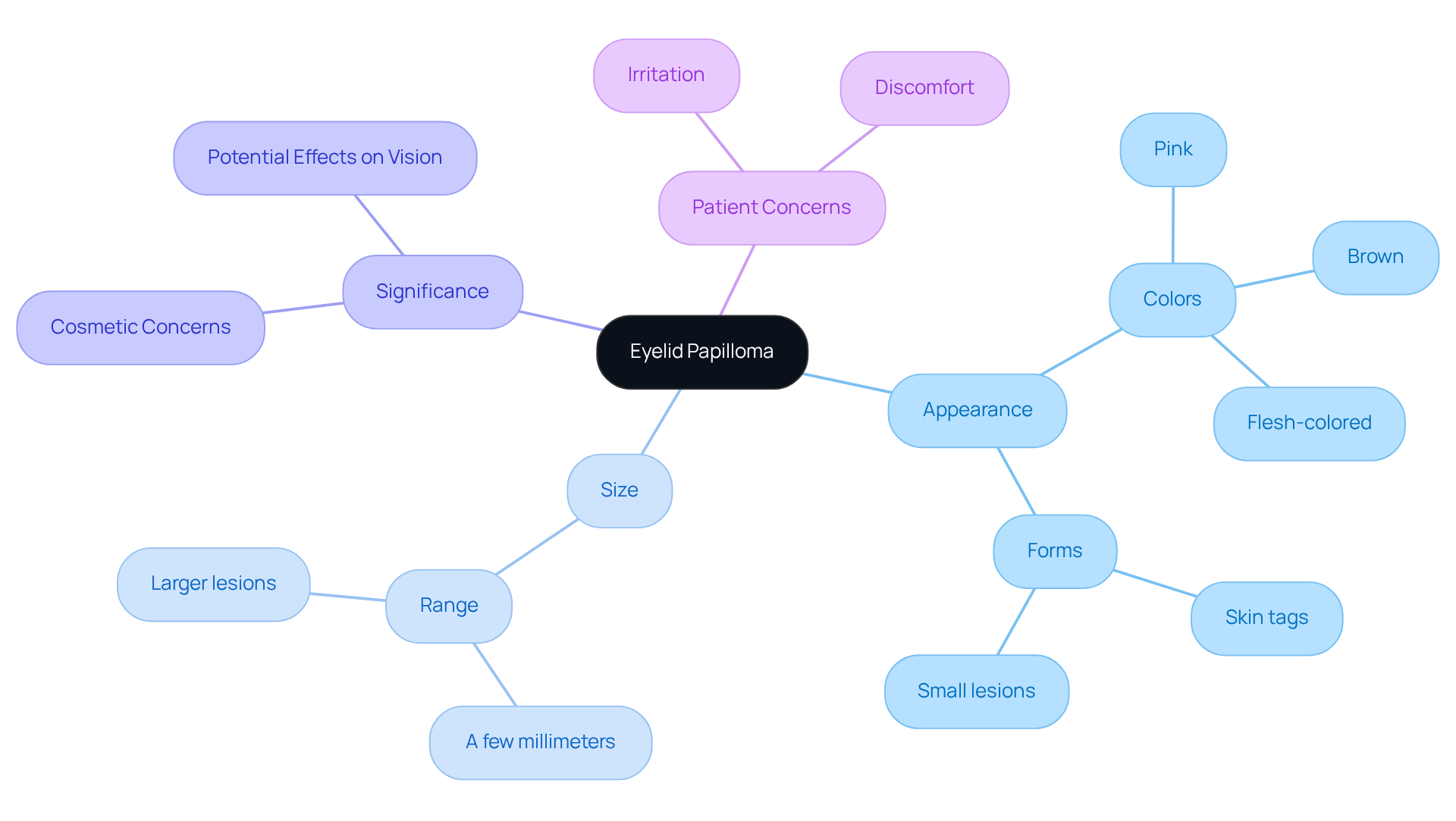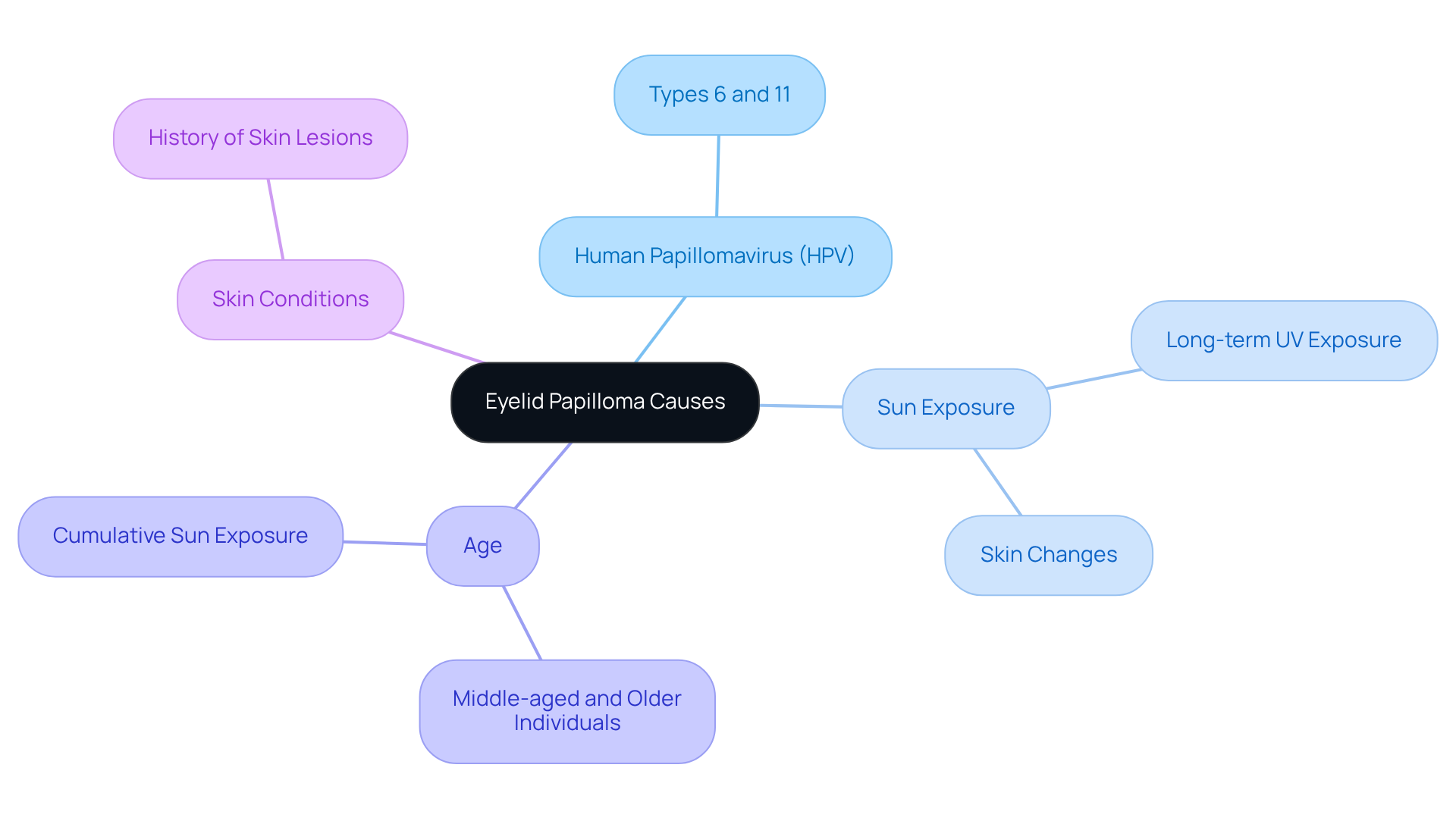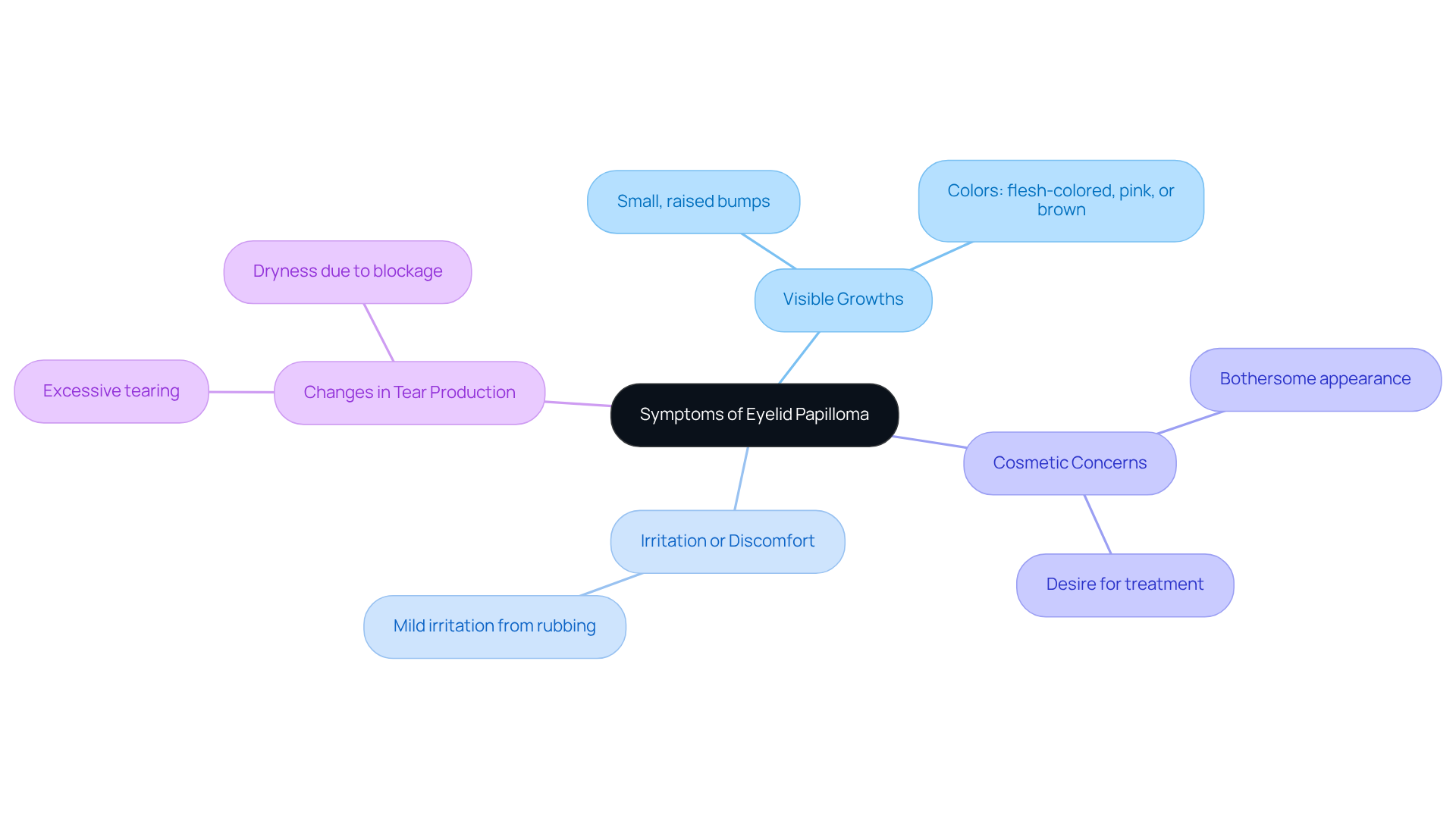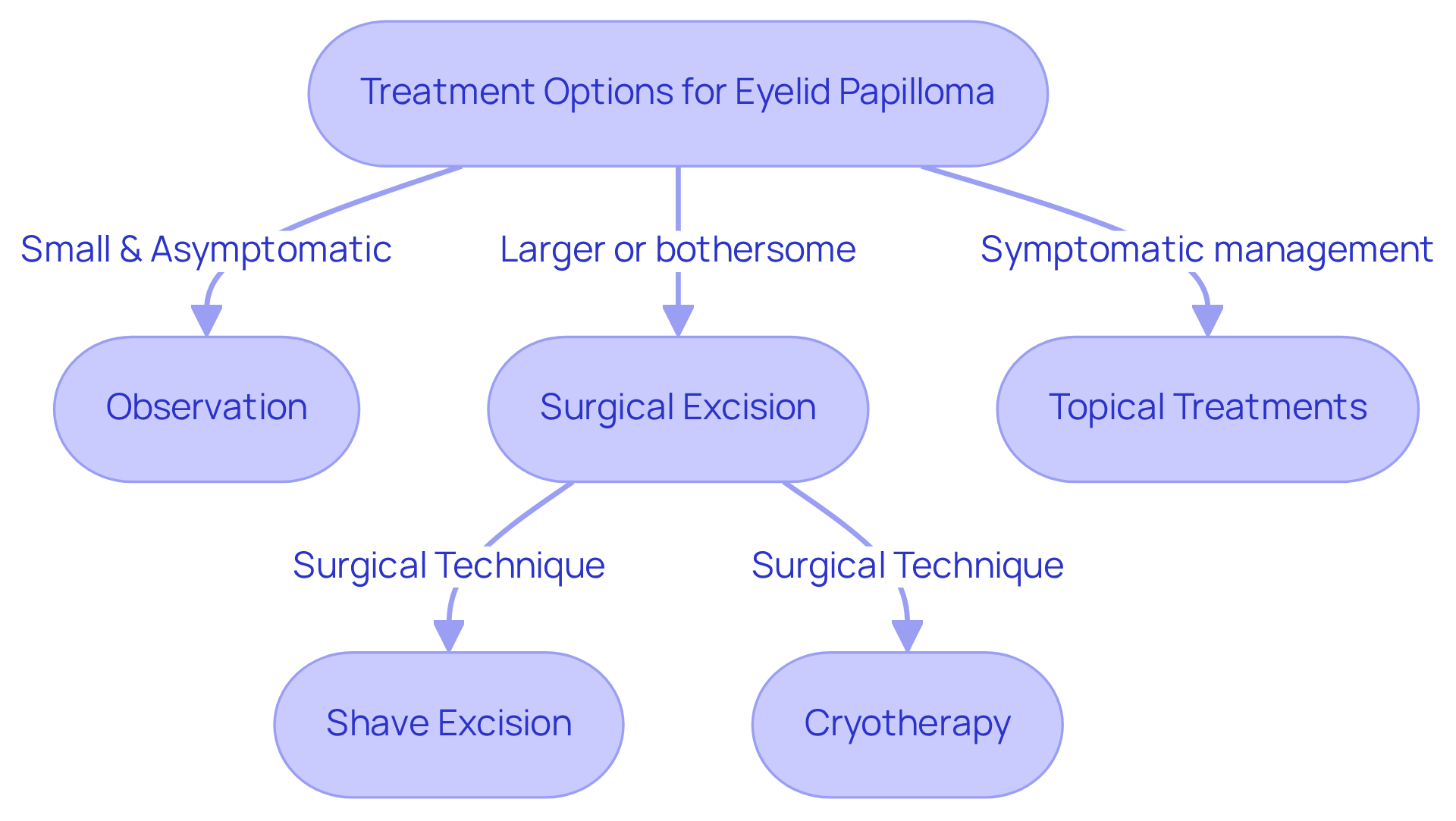Posted by: Northwest Eye in General on August 2, 2025
Overview
Eyelid papillomas are non-cancerous tumors that can appear on the eyelids, often leading to cosmetic concerns and, at times, irritation or discomfort. We understand that discovering such growths can be unsettling. These growths are typically linked to factors such as HPV infection, sun exposure, and age. It’s common to feel anxious about what this means for your health.
Treatment options range from simple observation to surgical excision. Early identification and appropriate management are crucial to mitigate potential complications. We are here to help you through this process, ensuring you receive the care and support you need. Remember, you are not alone in this journey, and there are effective ways to address your concerns.
Introduction
Eyelid papillomas, while non-cancerous, can significantly affect both your appearance and comfort. Often resembling skin tags or small lesions on the eyelids, these growths can understandably cause concern. We recognize how important it is to understand these conditions for early detection and effective treatment, as they may lead to cosmetic worries and even vision issues. You might be wondering what causes these benign tumors and how best to manage your symptoms and treatment options.
In this article, we will explore the key aspects of eyelid papillomas, including their causes, symptoms, and the various treatment pathways available to you.
Define Eyelid Papilloma: Overview and Significance
These growths are non-cancerous tumors known as eyelid papilloma that can appear on the upper eyelid, often looking like skin tags or small lesions. They typically come in flesh-colored, pink, or brown shades and can vary in size, ranging from just a few millimeters to larger lesions. While these growths are non-cancerous, we understand that they can raise cosmetic concerns and, in some instances, may cause irritation or discomfort.
Comprehending these growths in the eyelash region is vital for early identification and treatment. Eyelid papilloma is considered one of the most common non-cancerous tumors observed in clinical practice. Their significance lies in their potential to affect vision and the overall aesthetic appearance of the eyes. This can lead many patients to seek treatment, and we are here to help you through this process.

Identify Causes of Eyelid Papilloma: Risk Factors and Triggers
The precise reason for eyelid papilloma can often leave us feeling uncertain. However, we understand that recognizing certain risk factors and triggers can provide clarity and reassurance. Here are some important considerations:
- Human Papillomavirus (HPV): Certain strains of HPV, particularly types 6 and 11, are commonly associated with the development of papillomas.
- Sun Exposure: Long-term ultraviolet (UV) exposure can lead to changes in the skin that may provoke the development of growths.
- Age: Eyelid papilloma growths are more common in middle-aged and older individuals, likely due to cumulative sun exposure and natural changes in the skin over time.
- Skin Conditions: If you have a history of skin conditions or lesions, you may be at a higher risk.
Understanding these factors can empower you to recognize your susceptibility and take preventive measures. Simple steps, such as using sunscreen and avoiding excessive sun exposure, can make a significant difference. Remember, we are here to help you through this process and support you in maintaining your health.

Recognize Symptoms of Eyelid Papilloma: What to Look For
Symptoms of eyelid papilloma can vary, and we understand that noticing changes on your eyelids can be concerning. Common signs to look out for include:
- Visible Growths: Papillomas typically present as small, raised bumps on the eyelid, which may be flesh-colored, pink, or brown.
- Irritation or Discomfort: It’s common to experience mild irritation, especially if the eyelid papilloma rubs against your eyelashes or the margin of your eyelids.
- Cosmetic Concerns: Many individuals seek treatment for eyelid papilloma due to the appearance of these growths, which can feel bothersome or unsightly.
- Changes in Tear Production: In certain instances, larger growths may block tear drainage, leading to excessive tearing or dryness.
Being aware of these symptoms can prompt you to seek medical advice sooner. Remember, taking this step can improve outcomes and reduce the risk of complications. We are here to help you through this process, providing support every step of the way.

Explore Treatment Options for Eyelid Papilloma: From Diagnosis to Recovery
Treatment for eyelid papilloma usually involves several key approaches, which vary based on the size, location, and symptoms of the growth. We understand that dealing with these growths can be concerning, and we are here to help you through this process.
- Observation: If the eyelid papilloma is small and asymptomatic, a watchful waiting approach may be recommended. It’s common to feel uncertain in these situations, but sometimes, no immediate action is necessary.
- Surgical Excision: For larger or bothersome eyelid papilloma growths, surgical removal is often the preferred treatment. This can be performed in an outpatient setting, and techniques may include:
- Shave Excision: A simple procedure where the growth is shaved off at the skin level.
- Cryotherapy: Freezing the growth to destroy the tissue, which can be effective for smaller lesions. We know that the idea of surgery can be daunting, but rest assured that these procedures are commonly performed and can lead to positive outcomes.
- Topical Treatments: In some cases, topical medications may be used to manage symptoms or reduce the size of the eyelid papilloma. Your comfort and well-being are our top priorities.
Post-operative care is crucial for recovery. We encourage you to monitor for any signs of infection or recurrence and to follow your ophthalmologist’s instructions closely. This will help ensure optimal healing and outcomes. Remember, we are here to support you every step of the way.

Conclusion
Eyelid papillomas, while non-cancerous, can be a significant concern for many individuals due to their potential impact on vision and cosmetic appearance. We understand that these growths can be unsettling, and gaining insight into their causes, symptoms, and treatment options is essential for effective management and peace of mind. By becoming aware of eyelid papillomas, you can take proactive steps toward identifying and addressing these lesions, ultimately enhancing your quality of life.
Throughout this article, we have highlighted key points, including the association of eyelid papillomas with factors such as:
- Human papillomavirus (HPV)
- Sun exposure
- Age
It’s common to feel uncertain about what to look for; recognizing symptoms like visible growths and irritation can lead to timely medical consultations and appropriate treatment. Various treatment options are available, from observation and surgical excision to topical treatments, allowing for tailored approaches based on your individual circumstances.
The importance of awareness and education surrounding eyelid papillomas cannot be overstated. By staying informed about the risk factors and treatment options, you empower yourself to seek help when necessary and maintain your ocular health. Taking proactive measures, such as regular skin checks and sun protection, can significantly reduce the likelihood of developing these growths. Remember, addressing concerns early on can lead to better outcomes and peace of mind. We are here to help you through this process.
Frequently Asked Questions
What is eyelid papilloma?
Eyelid papilloma is a non-cancerous tumor that can appear on the upper eyelid, often resembling skin tags or small lesions.
What do eyelid papillomas look like?
Eyelid papillomas typically come in flesh-colored, pink, or brown shades and can vary in size from just a few millimeters to larger lesions.
Are eyelid papillomas cancerous?
No, eyelid papillomas are non-cancerous tumors.
Why is it important to understand eyelid papillomas?
Understanding eyelid papillomas is vital for early identification and treatment, as they can affect vision and the aesthetic appearance of the eyes.
What concerns might patients have regarding eyelid papillomas?
Patients may have cosmetic concerns and, in some cases, experience irritation or discomfort due to eyelid papillomas.
How common are eyelid papillomas?
Eyelid papillomas are considered one of the most common non-cancerous tumors observed in clinical practice.






